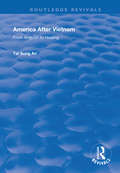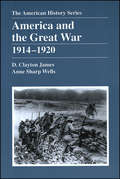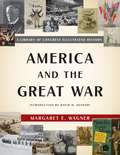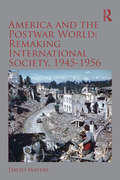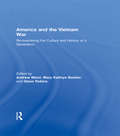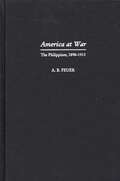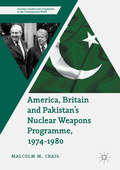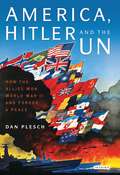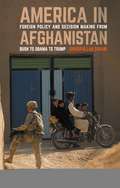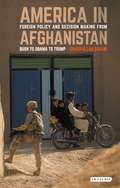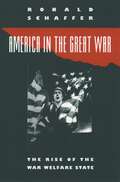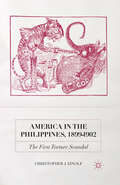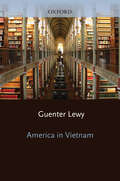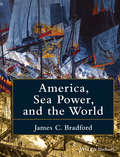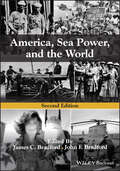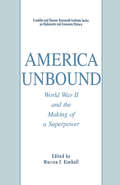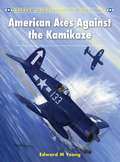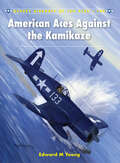- Table View
- List View
America After Vietnam: From Anguish to Healing (Routledge Revivals)
by Tai Sung AnFirst published in 1997, this volume explores the twenty years it has taken the United States to decide where Vietnam belongs on its mental landscape, as indicated by the establishment of official diplomatic relations between the two countries on August 5, 1995. Having won the Cold War, but lost a skirmish in Vietnam, America’s defeat can now be set in context against subsequent campaigns in Afghanistan, Angola, El Salvador, Eritrea, Nicaragua, Somalia, Sudan and elsewhere which suggest that the best any outsider can expect by intervening in Third World domestic conflicts is a hugely expensive, bloody stalemate. Tai Sung-An identifies that, despite America’s painful, deep and very expensive involvement in Vietnam for a lengthy two decades, Americans fought, failed and left while remaining ignorant of the most elementary knowledge of Vietnam, symptomatic of a cultural gap, isolationism and even intellectual complacency.
America and the Great War: 1914 - 1920 (The American History Series)
by D. Clayton James Anne Sharp WellsIn America and the Great War, 1914-1920, the accomplished writing team of D. Clayton James and Anne Sharp Wells provides a succinct account of the principal military, political, and social developments in United States History as the nation responded to, and was changed by, a world in crisis. A forthright examination of America's unprecedented military commitment and actions abroad, America and the Great War includes insights into the personalities of key Allied officers and civilian leaders as well as the evolution of the new American "citizen soldier." Full coverage is given to President Wilson's beleaguered second term, the experience of Americans-including women, minorities, and recent arrivals-on the home front, and the lasting changes left in the Great War's wake.
America and the Great War: A Library of Congress Illustrated History
by David M. Kennedy Margaret E. WagnerChoice Magazine Outstanding Academic Titles of the Year for 2017"A uniquely colorful chronicle of this dramatic and convulsive chapter in American--and world--history. It's an epic tale, and here it is wondrously well told." --David M. Kennedy, Pulitzer Prize-winning historian and author of FREEDOM FROM FEARFrom August 1914 through March 1917, Americans were increasingly horrified at the unprecedented destruction of the First World War. While sending massive assistance to the conflict's victims, most Americans opposed direct involvement. Their country was immersed in its own internal struggles, including attempts to curb the power of business monopolies, reform labor practices, secure proper treatment for millions of recent immigrants, and expand American democracy. Yet from the first, the war deeply affected American emotions and the nation's commercial, financial, and political interests. The menace from German U-boats and failure of U.S. attempts at mediation finally led to a declaration of war, signed by President Wilson on April 6, 1917. America and the Great War commemorates the centennial of that turning point in American history. Chronicling the United States in neutrality and in conflict, it presents events and arguments, political and military battles, bitter tragedies and epic achievements that marked U.S. involvement in the first modern war. Drawing on the matchless resources of the Library of Congress, the book includes many eyewitness accounts and more than 250 color and black-and-white images, many never before published. With an introduction by Pulitzer Prize–winning historian David M. Kennedy, America and the Great War brings to life the tempestuous era from which the United States emerged as a major world power.
America and the Postwar World: Remaking International Society, 1945-1956 (Routledge Studies in Modern History)
by David MayersThe main tide of international relations scholarship on the first years after World War II sweeps toward Cold War accounts. These have emphasized the United States and USSR in a context of geopolitical rivalry, with concomitant attention upon the bristling security state. Historians have also extensively analyzed the creation of an economic order (Bretton Woods), mainly designed by Americans and tailored to their interests, but resisted by peoples residing outside of North America, Western Europe, and Japan. This scholarship, centered on the Cold War as vortex and a reconfigured world economy, is rife with contending schools of interpretation and, bolstered by troves of declassified archival documents, will support investigations and writing into the future. By contrast, this book examines a past that ran concurrent with the Cold War and interacted with it, but which usefully can also be read as separable: Washington in the first years after World War II, and in response to that conflagration, sought to redesign international society. That society was then, and remains, an admittedly amorphous thing. Yet it has always had a tangible aspect, drawing self-regarding states into occasional cooperation, mediated by treaties, laws, norms, diplomatic customs, and transnational institutions. The U.S.-led attempt during the first postwar years to salvage international society focused on the United Nations Relief and Rehabilitation Administration, the Acheson–Lilienthal plan to contain the atomic arms race, the Nuremberg and Tokyo tribunals to force Axis leaders to account, the 1948 Genocide Convention, the 1948 Universal Declaration of Human Rights, and the founding of the United Nations. None of these initiatives was transformative, not individually or collectively. Yet they had an ameliorative effect, traces of which have touched the twenty-first century—in struggles to curb the proliferation of nuclear weapons, bring war criminals to justice, create laws supportive of human rights, and maintain an aspirational United Nations, still striving to retain meaningfulness amid world hazards. Together these partially realized innovations and frameworks constitute, if nothing else, a point of moral reference, much needed as the border between war and peace has become blurred and the consequences of a return to unrestraint must be harrowing.
America and the Postwar World: Remaking International Society, 1945-1956 (Routledge Studies in Modern History)
by David MayersThe main tide of international relations scholarship on the first years after World War II sweeps toward Cold War accounts. These have emphasized the United States and USSR in a context of geopolitical rivalry, with concomitant attention upon the bristling security state. Historians have also extensively analyzed the creation of an economic order (Bretton Woods), mainly designed by Americans and tailored to their interests, but resisted by peoples residing outside of North America, Western Europe, and Japan. This scholarship, centered on the Cold War as vortex and a reconfigured world economy, is rife with contending schools of interpretation and, bolstered by troves of declassified archival documents, will support investigations and writing into the future. By contrast, this book examines a past that ran concurrent with the Cold War and interacted with it, but which usefully can also be read as separable: Washington in the first years after World War II, and in response to that conflagration, sought to redesign international society. That society was then, and remains, an admittedly amorphous thing. Yet it has always had a tangible aspect, drawing self-regarding states into occasional cooperation, mediated by treaties, laws, norms, diplomatic customs, and transnational institutions. The U.S.-led attempt during the first postwar years to salvage international society focused on the United Nations Relief and Rehabilitation Administration, the Acheson–Lilienthal plan to contain the atomic arms race, the Nuremberg and Tokyo tribunals to force Axis leaders to account, the 1948 Genocide Convention, the 1948 Universal Declaration of Human Rights, and the founding of the United Nations. None of these initiatives was transformative, not individually or collectively. Yet they had an ameliorative effect, traces of which have touched the twenty-first century—in struggles to curb the proliferation of nuclear weapons, bring war criminals to justice, create laws supportive of human rights, and maintain an aspirational United Nations, still striving to retain meaningfulness amid world hazards. Together these partially realized innovations and frameworks constitute, if nothing else, a point of moral reference, much needed as the border between war and peace has become blurred and the consequences of a return to unrestraint must be harrowing.
America and the Vietnam War: Re-examining the Culture and History of a Generation
by Andrew Wiest Mary Kathryn Barbier Glenn RobinsThe Vietnam War was one of the most heavily documented conflicts of the twentieth century. Although the events themselves recede further into history every year, the political and cultural changes the war brought about continue to resonate, even as a new generation of Americans grapples with its own divisive conflict. America and the Vietnam War: Re-examining the Culture and History of a Generation reconsiders the social and cultural aspects of the conflict that helped to fundamentally change the nation. With chapters written by subject area specialists, America and the Vietnam War takes on subjects such as women’s role in the war, the music and the films of the time, the Vietnamese perspective, race and the war, and veterans and post-traumatic stress disorder. Features include: chapter summaries timelines discussion questions guides to further reading a companion website with primary source documents and tools (such as music and movie playlists) for both instructors and students. Heavily illustrated and welcoming to students and scholars of this infamous and pivotal time, America and the Vietnam War is a perfect companion to any course on the Vietnam War Era.
America and the Vietnam War: Re-examining the Culture and History of a Generation
by Andrew Wiest Mary Kathryn Barbier Glenn RobinsThe Vietnam War was one of the most heavily documented conflicts of the twentieth century. Although the events themselves recede further into history every year, the political and cultural changes the war brought about continue to resonate, even as a new generation of Americans grapples with its own divisive conflict. America and the Vietnam War: Re-examining the Culture and History of a Generation reconsiders the social and cultural aspects of the conflict that helped to fundamentally change the nation. With chapters written by subject area specialists, America and the Vietnam War takes on subjects such as women’s role in the war, the music and the films of the time, the Vietnamese perspective, race and the war, and veterans and post-traumatic stress disorder. Features include: chapter summaries timelines discussion questions guides to further reading a companion website with primary source documents and tools (such as music and movie playlists) for both instructors and students. Heavily illustrated and welcoming to students and scholars of this infamous and pivotal time, America and the Vietnam War is a perfect companion to any course on the Vietnam War Era.
America at War: The Philippines, 1898-1913
by A. B. FeuerUsing previously unpublished diaries, letters, and photographs—plus the writings of war correspondent John T. McCutcheon—Feuer offers a vivid account of America's war in the Philippine Islands during the early part of the 20th century. This story highlights the experiences of the American soldiers, sailors, and marines who participated in the major battles. Not only did they fight a determined enemy, they also battled the weather, the jungle, and the diseases that threatened to take their lives. Their writings, including a section of poems and songs of the era, reveal the thoughts and anxieties of the American fighting man, serving his country nearly 8,000 miles from home.In 1895 Emilio Aguinaldo became the leader of Katipunan, a revolutionary society that sought complete independence from Spain. A year later, his ragtag band of soldiers defeated a Spanish regiment, a victory that incited the Filipino people to rise up against their oppressors. While the Spanish ultimately paid Aguinaldo to enter voluntary exile, in 1898, after the sinking of the ^IMaine^R, the United States would promise independence for the islands in exchange for Aguinaldo's return to lead an uprising against Spain. The U.S. State Department would later repudiate this promise, a move that would embroil United States troops in a bloody struggle to subdue the islands. This is their story.
America, Britain and Pakistan’s Nuclear Weapons Programme, 1974-1980: A Dream of Nightmare Proportions
by Malcolm M. CraigThis book analyses US and UK efforts to shut down Pakistan’s nuclear programme in the 1970s, between the catalytic Indian nuclear test of May 1974 and the decline of sustained non-proliferation activity from mid-1979 onwards. It is a tale of cooperation between Washington and London, but also a story of divisions and disputes. The brutal economic realities of the decade, globalisation, and wider geopolitical challenges all complicated this relationship. Policy and action were also affected by changes elsewhere in the world. Iran’s 1979 revolution brought a new form of political Islamic radicalism to prominence. The fears engendered by the Ayatollah and his followers, coupled to the blustering rhetoric of Pakistani leaders, gave rise to the ‘Islamic bomb’, a nuclear weapon supposedly created by Pakistan to be shared amongst the Muslim ummah. This study thus combines cultural, diplomatic, economic, and political history to offer a rigorous, deeply researched account of a critical moment in nuclear history.
America, Britain and Pakistan’s Nuclear Weapons Programme, 1974-1980: A Dream of Nightmare Proportions
by Malcolm M. CraigThis book analyses US and UK efforts to shut down Pakistan’s nuclear programme in the 1970s, between the catalytic Indian nuclear test of May 1974 and the decline of sustained non-proliferation activity from mid-1979 onwards. It is a tale of cooperation between Washington and London, but also a story of divisions and disputes. The brutal economic realities of the decade, globalisation, and wider geopolitical challenges all complicated this relationship. Policy and action were also affected by changes elsewhere in the world. Iran’s 1979 revolution brought a new form of political Islamic radicalism to prominence. The fears engendered by the Ayatollah and his followers, coupled to the blustering rhetoric of Pakistani leaders, gave rise to the ‘Islamic bomb’, a nuclear weapon supposedly created by Pakistan to be shared amongst the Muslim ummah. This study thus combines cultural, diplomatic, economic, and political history to offer a rigorous, deeply researched account of a critical moment in nuclear history.
America, Hitler and the UN: How the Allies Won World War II and Forged a Peace
by Dan PleschIn January 1942, the Declaration by United Nations forged a military alliance based on human rights principles that included over 24 countries, marking the beginning of the UN. But how did the armies of the United Nations co-operate during World War II to halt Nazi expansionism? When did the UN start to tackle the international economic and social challenges of the post-war world? This is the first book to explore how the profound restructuring of the international world order was organized. Drawing on previously unknown archival material, Plesch analyzes the engagement with the UN by all levels of society, from grassroots to the political elites. Plesch has pieced together the full story of how the UN intervened in surprising ways at a pivotal time in world history and argues that the UN s success is as vital today as it was then."
America in Afghanistan: Foreign Policy and Decision Making From Bush to Obama to Trump (Library of Modern Middle East Studies)
by Sharifullah DoraniAfghanistan has been a theatre of civil and international conflict for much of the twentieth century – stability is essential if there is to be peace in the Greater Middle East. Yet policy-makers in the West often seem to forget the lessons learned from previous administrations, whose interventions have contributed to the instability in the region. Here, Sharifullah Dorani focuses on the process of decision-making, looking at which factors influenced American policy-makers in the build-up to its longest war, the Afghanistan War, and how reactions on the ground in Afghanistan have influenced events since then. America in Afghanistan is a new, full history of US foreign policy toward Afghanistan from Bush's 'War on Terror', to Obama's war of 'Countering Violent Extremism' to Trump's war against 'Radical Islamic Terrorism'. Dorani is fluent in Pashto and Dari and uses unique and unseen Afghan source-work, published here for the first time, to understand the people in Afghanistan itself, and to answer their unanswered questions about 'real' US Afghan goals, the reasons for US failures in Afghanistan, especially its inability to improve governance and stop Pakistan, Iran and Russia from supporting the insurgency in Afghanistan, and the reasons for the bewildering changes in US Afghan policy over the course of 16 and a half years. To that end the author also assesses Presidents Karzai and Ghani's responses to Bush, Obama and Trump's policies in Afghanistan and the region. In addition, the book covers the role Afghanistan's neighbours – Russia, Iran, India, and especially Pakistan – played in America's Afghanistan War. This will be an essential book for those interested in the future of the region, and those who seek to understand its recent past.
America in Afghanistan: Foreign Policy and Decision Making From Bush to Obama to Trump (Library of Modern Middle East Studies)
by Sharifullah DoraniAfghanistan has been a theatre of civil and international conflict for much of the twentieth century – stability is essential if there is to be peace in the Greater Middle East. Yet policy-makers in the West often seem to forget the lessons learned from previous administrations, whose interventions have contributed to the instability in the region. Here, Sharifullah Dorani focuses on the process of decision-making, looking at which factors influenced American policy-makers in the build-up to its longest war, the Afghanistan War, and how reactions on the ground in Afghanistan have influenced events since then. America in Afghanistan is a new, full history of US foreign policy toward Afghanistan from Bush's 'War on Terror', to Obama's war of 'Countering Violent Extremism' to Trump's war against 'Radical Islamic Terrorism'. Dorani is fluent in Pashto and Dari and uses unique and unseen Afghan source-work, published here for the first time, to understand the people in Afghanistan itself, and to answer their unanswered questions about 'real' US Afghan goals, the reasons for US failures in Afghanistan, especially its inability to improve governance and stop Pakistan, Iran and Russia from supporting the insurgency in Afghanistan, and the reasons for the bewildering changes in US Afghan policy over the course of 16 and a half years. To that end the author also assesses Presidents Karzai and Ghani's responses to Bush, Obama and Trump's policies in Afghanistan and the region. In addition, the book covers the role Afghanistan's neighbours – Russia, Iran, India, and especially Pakistan – played in America's Afghanistan War. This will be an essential book for those interested in the future of the region, and those who seek to understand its recent past.
America in the Great War: The Rise of the War Welfare State
by Ronald SchafferAfter such conflicts as World War II, Vietnam, and now the Persian Gulf, the First World War seems a distant, almost ancient event. It conjures up images of trenches, horse-drawn wagons, and old-fashioned wide-brimmed helmets--a conflict closer to the Civil War than to our own time. It hardly seems an American war at all, considering we fought for scarcely over a year in a primarily European struggle. But, as Ronald Schaffer recounts in this fascinating new book, the Great War wrought a dramatic revolution in America, wrenching a diverse, unregulated, nineteenth-century society into the modern age. Ranging from the Oval Office to corporate boardroom, from the farmyard to the battlefield, America in the Great War details a nation reshaped by the demands of total war. Schaffer shows how the Wilson Administration used persuasion, manipulation, direct control, and the cooperation of private industries and organizations to mobilize a freewheeling, individualist country. The result was a war-welfare state, imposing the federal government on almost every aspect of American life. He describes how it spread propaganda, enforced censorship, and stifled dissent. Political radicals, religious pacifists, German-Americans, even average people who voiced honest doubts about the war suffered arrest and imprisonment. The government extended its control over most of the nation's economic life through a series of new agencies--largely filled with managers from private business, who used their new positions to eliminate competition and secure other personal and corporate gains. Schaffer also details the efforts of scholars, scientists, workers, women, African- Americans, and of social, medical, and moral reformers, to use the war to advance their own agendas even as they contributed to the drive for victory. And not the least important is his account of how soldiers reacted to the reality of war--both at the front lines and at the rear--revealing what brought the doughboys to the battlefield, and how they went through not only horror and disillusionment but felt a fervent patriotism as well. Some of the upheavals Schaffer describes were fleeting--as seen in the thousands of women who had to leave their wartime jobs when the boys came home--but others meant permanent change and set precedents for such future programs as the New Deal. By showing how American life would never be the same again after the Armistice, America in the Great War lays a new foundation for understanding both the First World War and twentieth-century America.
America in the Great War: The Rise of the War Welfare State
by Ronald SchafferAfter such conflicts as World War II, Vietnam, and now the Persian Gulf, the First World War seems a distant, almost ancient event. It conjures up images of trenches, horse-drawn wagons, and old-fashioned wide-brimmed helmets--a conflict closer to the Civil War than to our own time. It hardly seems an American war at all, considering we fought for scarcely over a year in a primarily European struggle. But, as Ronald Schaffer recounts in this fascinating new book, the Great War wrought a dramatic revolution in America, wrenching a diverse, unregulated, nineteenth-century society into the modern age. Ranging from the Oval Office to corporate boardroom, from the farmyard to the battlefield, America in the Great War details a nation reshaped by the demands of total war. Schaffer shows how the Wilson Administration used persuasion, manipulation, direct control, and the cooperation of private industries and organizations to mobilize a freewheeling, individualist country. The result was a war-welfare state, imposing the federal government on almost every aspect of American life. He describes how it spread propaganda, enforced censorship, and stifled dissent. Political radicals, religious pacifists, German-Americans, even average people who voiced honest doubts about the war suffered arrest and imprisonment. The government extended its control over most of the nation's economic life through a series of new agencies--largely filled with managers from private business, who used their new positions to eliminate competition and secure other personal and corporate gains. Schaffer also details the efforts of scholars, scientists, workers, women, African- Americans, and of social, medical, and moral reformers, to use the war to advance their own agendas even as they contributed to the drive for victory. And not the least important is his account of how soldiers reacted to the reality of war--both at the front lines and at the rear--revealing what brought the doughboys to the battlefield, and how they went through not only horror and disillusionment but felt a fervent patriotism as well. Some of the upheavals Schaffer describes were fleeting--as seen in the thousands of women who had to leave their wartime jobs when the boys came home--but others meant permanent change and set precedents for such future programs as the New Deal. By showing how American life would never be the same again after the Armistice, America in the Great War lays a new foundation for understanding both the First World War and twentieth-century America.
America in the Philippines, 1899-1902: The First Torture Scandal
by Christopher J. EinolfAmerica in the Philippines, 1899-1902: The First Torture Scandal analyzes the US army's use of the 'water cure' torture in the Philippine War and the ensuing political scandal that resulted. Drawing on primary source documents to construct a detailed narrative history of the events, the book also proposes an original theory for the causes of torture, which emphasizes the moral agency of low-level actors. Einolf uses the historical debate to illuminate theories of present-day human rights advocacy. The conclusion relates the Philippine War case to the more recent use of torture under the George W. Bush administration and makes recommendations for researchers and advocates.
America in Vietnam
by Guenter LewyBased on a variety of classified military records, Lewy provides the first systematic analysis of the course of the Vietnam War, the reasons for the failure of American strategy and tactics, and the causes of the final collapse of South Vietnam.
America in Vietnam
by Guenter LewyBased on a variety of classified military records, Lewy provides the first systematic analysis of the course of the Vietnam War, the reasons for the failure of American strategy and tactics, and the causes of the final collapse of South Vietnam.
America, Sea Power, and the World
by James C. BradfordThis survey of American naval history features original chapters from key scholars in the field that trace the relationship between the American Navy and the position of the United States on the global political stage over the past 250 years. Places equal weight on the influence of major wartime campaigns and naval efforts to defend and expand America’s political and economic interests during times of peace Includes an array of illustrations and 56 new maps, seamlessly integrated within each chapter Each chapter features sidebars with biographical sketches of influential leaders and descriptions of weapons and technological developments of the era
America, Sea Power, and the World
by James C. BradfordThis survey of American naval history features original chapters from key scholars in the field that trace the relationship between the American Navy and the position of the United States on the global political stage over the past 250 years. Places equal weight on the influence of major wartime campaigns and naval efforts to defend and expand America’s political and economic interests during times of peace Includes an array of illustrations and 56 new maps, seamlessly integrated within each chapter Each chapter features sidebars with biographical sketches of influential leaders and descriptions of weapons and technological developments of the era
America, Sea Power, and the World
by James C. Bradford John F. BradfordThe gold standard in college-level American naval history texts, edited by the foremost scholar in the field In the newly revised second edition of America, Sea Power and the World, a team of distinguished researchers delivers an extensive and authoritative survey of American naval history, the place of the United States in world affairs, and the role of that country’s naval forces during peacetime and wartime. Each chapter contains a comprehensive analysis of its subject as well as brief sidebars describing a key weapon or technological development of the era and a short biographical sketch of an influential leader or representative of the navy from that era. The book offers extensive illustration and maps and a throughgoing emphasis on naval policy, strategy, roles, and missions, with careful attention paid to naval operations. These factors given greater focus than the descriptions of battle tactics found in other texts. Readers will also find: A thorough introduction to sea power and the modern state system, as well as the American War for Independence at sea Comprehensive explorations of the genesis of the United States Navy from 1785 to 1806 Practical discussions of the Naval War of 1812 and the Confirmation of Independence from 1807 to 1815 and the Squadron Navy as an agent of the commercial empire until 1890 Fulsome treatments of the Second World War in the Atlantic, Mediterranean, and the Pacific, including defensive actions in the Pacific from 1937 to 1943 and offensive actions from 1943 to 1944. New chapters exclusive to the 2nd edition focused on the history of African Americans and women in the US Navy, the development of joint operations and unified command, and the naval history of the last two decades.Perfect for undergraduate students taking courses on the naval history of the United States, America, Sea Power and the World, Second Edition will also earn a place in the libraries of members of the general public interested in naval and military history.
America, Sea Power, and the World
by James C. Bradford John F. BradfordThe gold standard in college-level American naval history texts, edited by the foremost scholar in the field In the newly revised second edition of America, Sea Power and the World, a team of distinguished researchers delivers an extensive and authoritative survey of American naval history, the place of the United States in world affairs, and the role of that country’s naval forces during peacetime and wartime. Each chapter contains a comprehensive analysis of its subject as well as brief sidebars describing a key weapon or technological development of the era and a short biographical sketch of an influential leader or representative of the navy from that era. The book offers extensive illustration and maps and a throughgoing emphasis on naval policy, strategy, roles, and missions, with careful attention paid to naval operations. These factors given greater focus than the descriptions of battle tactics found in other texts. Readers will also find: A thorough introduction to sea power and the modern state system, as well as the American War for Independence at sea Comprehensive explorations of the genesis of the United States Navy from 1785 to 1806 Practical discussions of the Naval War of 1812 and the Confirmation of Independence from 1807 to 1815 and the Squadron Navy as an agent of the commercial empire until 1890 Fulsome treatments of the Second World War in the Atlantic, Mediterranean, and the Pacific, including defensive actions in the Pacific from 1937 to 1943 and offensive actions from 1943 to 1944. New chapters exclusive to the 2nd edition focused on the history of African Americans and women in the US Navy, the development of joint operations and unified command, and the naval history of the last two decades.Perfect for undergraduate students taking courses on the naval history of the United States, America, Sea Power and the World, Second Edition will also earn a place in the libraries of members of the general public interested in naval and military history.
America Unbound: World War II and the Making of a Superpower (The World of the Roosevelts)
Whether World War II made or merely marked the transition of the United States from a major world power to a superpower, the fact remains that America's role in the world around it had undergone a dramatic change. Other nations had long recognized the potential of the United States. They had seen its power exercised regularly in economics, if only sparodically in politics. But World War II, and the landscape it left behind, prompted American leaders and the Congress to conclude that they had to use the nation's strength to protect and advance its interests.
American Aces against the Kamikaze (Aircraft of the Aces #109)
by Mark Styling Edward M. YoungThe Japanese High Command realised that the loss of Okinawa would give the Americans a base for the invasion of Japan. Its desperate response was to unleash the full force of the Special Attack Units, known in the west as the Kamikaze ('Divine Wind'). In a series of mass attacks in between April and June 1945, more than 900 Kamikaze aeroplanes were shot down. Conventional fighters and bombers accompanied the Special Attack Units as escorts, and to add their own weight to the attacks on the US fleet. In the air battles leading up to the invasion of Okinawa, as well as those that raged over the island in the three months that followed, the Japanese lost more than 7,000 aircraft both in the air and on the ground. In the course of the fighting, 67 Navy, 21 Marine, and three USAAF pilots became aces. In many ways it was an uneven combat and on numerous occasions following these uneven contests, American fighter pilots would return from combat having shot down up to six Japanese aeroplanes during a single mission.
American Aces against the Kamikaze (Aircraft of the Aces #109)
by Edward M. YoungThe Japanese High Command realised that the loss of Okinawa would give the Americans a base for the invasion of Japan. Its desperate response was to unleash the full force of the Special Attack Units, known in the west as the Kamikaze ('Divine Wind'). In a series of mass attacks in between April and June 1945, more than 900 Kamikaze aeroplanes were shot down. Conventional fighters and bombers accompanied the Special Attack Units as escorts, and to add their own weight to the attacks on the US fleet. In the air battles leading up to the invasion of Okinawa, as well as those that raged over the island in the three months that followed, the Japanese lost more than 7,000 aircraft both in the air and on the ground. In the course of the fighting, 67 Navy, 21 Marine, and three USAAF pilots became aces. In many ways it was an uneven combat and on numerous occasions following these uneven contests, American fighter pilots would return from combat having shot down up to six Japanese aeroplanes during a single mission.
